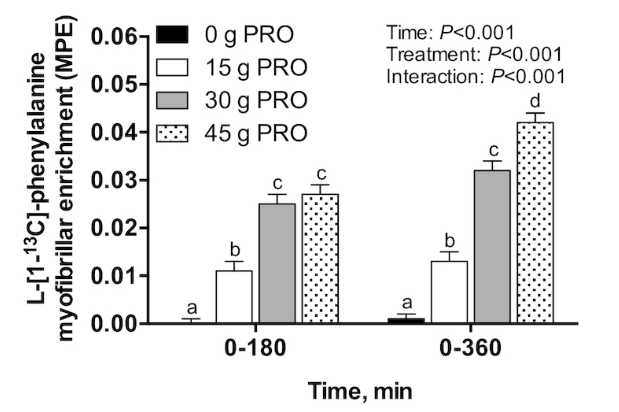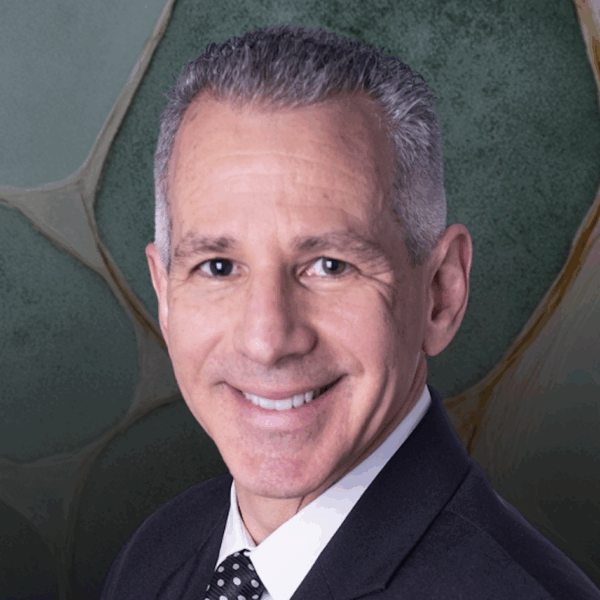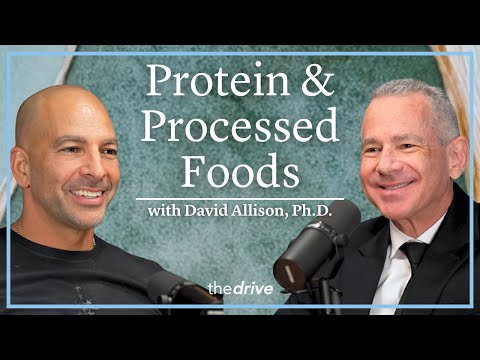David Allison is a world-renowned scientist and award-winning scientific writer who has spent more than two decades at the forefront of obesity research. In this episode, David joins for his third appearance on The Drive to bring clarity to one of the most contentious topics in modern nutrition—protein. He explores the historical pattern of demonizing macronutrients, the origins and limitations of the RDA for protein, and what the evidence really says about higher protein intake, muscle protein synthesis, and whether concerns about harm are supported by actual data. He also discusses the challenges of conducting rigorous nutrition studies, including the limits of epidemiology and crossover designs, as well as conflicts of interest in nutrition science and why transparency around data, methods, and logic matter more than funding sources. The episode closes with a discussion on processed and ultra-processed foods, the public health challenges of tackling obesity, and whether future solutions may depend more on drugs like GLP-1 agonists or broader societal changes. This is part one of a two-part deep dive on protein, setting the stage for next week’s conversation with Rhonda Patrick.
Subscribe on: APPLE PODCASTS | SPOTIFY | RSS | OVERCAST
“My mission for The Peter Attia Drive has always been to provide you with the most rigorous, evidence-informed insights on longevity. To do that without cluttering your experience with ads, we rely entirely on our premium members. If you’d like to support the work that makes this mission possible, consider becoming a premium member.”
– Peter
We discuss:
Timestamps: There are two sets of timestamps associated with the topic list below. The first is audio (A), and the second is video (V). If you are listening to this podcast with the audio player on this page or in your favorite podcast player, please refer to the audio timestamps. If you are watching the video version on this page or YouTube, please refer to the video timestamps.
- The cyclical pattern of demonizing different macronutrients in nutrition and why protein has recently become the latest target of controversy [A: 3:15, V: 0:10];
- The origin and limits of the protein RDA: from survival thresholds to modern optimization [A: 6:30, V: 4:03];
- Trust vs. trustworthiness: why data, methods, and logic matter more than motives in science [A: 13:30, V: 11:50];
- The challenges of nutrition science: methodological limits, emotional bias, and the path to honest progress [A: 17:15, V: 16:07];
- Why the protein RDA is largely inadequate for most people, and the lack of human evidence that high protein intake is harmful [A: 30:30, V: 30:53];
- Understanding the dose-response curve for muscle protein synthesis as protein intake increases [A: 45:15, V: 48:17];
- Why nutrition trials are chronically underpowered due to weak economic incentives, and how this skews evidence quality and perceptions of conflict [A: 48:15, V: 51:27];
- The limitations and biases of nutrition epidemiology, and the potential role of AI-assisted review to improve it [A: 56:15, V: 1:00:40];
- The lack of compelling evidence of harm with higher protein intake, and why we should shift away from assuming danger [A: 1:04:15, V: 1:09:41];
- Pragmatic targets for protein intake [A: 1:09:30, V: 1:15:37];
- Defining processed and ultra-processed foods and whether they are inherently harmful [A: 1:16:15, V: 1:23:44];
- The search for a guiding principle of what’s healthy to eat: simple heuristics vs. judging foods by their molecular composition [A: 1:25:00, V: 1:34:16];
- Why conventional public health interventions for obesity have largely failed [A: 1:38:15, V: 1:49:14];
- Two ideas from David for addressing the metabolic health problem in society [A: 1:42:30, V: 1:54:33];
- The potential of GLP-1 agonists to play a large role in public health [A: 1:46:30, V: 1:59:21]; and
- More.
Show Notes
The cyclical pattern of demonizing different macronutrients in nutrition and why protein has recently become the latest target of controversy [A: 3:15, V: 0:10]
- David just got a great new gig at the Children’s Nutrition Research Center in Houston, Texas and Baylor College of Medicine in Texas Children’s Hospital
- We’re going to start by talking about something that Peter doesn’t want to talk about (he’s sick and tired of talking about it), but this is a topic that has gone from being pretty straightforward to somewhat contentious
- He apologizes in advance to all the listeners, they’re probably sick and tired of hearing about this
- He will do his best to refrain from speculating on the reasons why it has become contentious
- Let’s try to dive into the arguments around the macronutrient that is more in the crosshairs than any other today, which is protein
- That’s interesting when you consider the arc of David’s career
- It was certainly easy to understand how people demonized fat and then they demonized carbs
- Here we are today, come in full circle, we’re demonizing protein
Where do you place the demonization of protein in the arc of the historical lens of nutrition?
- It shows many things, but at some level, it’s almost perfectly predictable, which is: we all eat, we eat every day
- Eating is part of our sustenance, but it’s part of culture, family, certainly part of economics, identity, social class, religion, and so on
- So, it’s fun to talk about and there’s lots of motivations, motivations people recognize and motivations they may not recognize
- That leads always to this attention on it
That attention drives a big economic engine of food sales ‒ there’s lots of interest in this and lots of stakes in this (if you’ll pardon the pun)
- People shift, and it’s not even just the macronutrients
- This week, it’s seed oils, and next week, it’s phytoestrogens and soybean feminizing youth
“It’s one thing after another where people look for the villains and the heroes and the angels and the demons in food.”‒ David Allison
- There are only 3 macronutrients, so they keep looping around
- Protein has become in the last few years almost a fever pitch of enthusiasm and excitement from one part of the community, and it’s driving sales and it’s driving behavior
- Some people like David are having fun with it
- There’s always that group that sees other people having fun or making money and heaven forbid doing something that might be seen as the easy way out or the contrived or constructed way out as opposed to the so-called natural way out of doing something and then that upsets them, that offends them
- You’re not being prudent, you’re not taking the natural course, you’re not taking the old-fashioned course, you’re having too much fun, you’re trying too hard to achieve big things (we don’t like that)
- So, we’re going to try to pooh-pooh it or shut it down or minimize it.
- That’s where David thinks things are
- Peter presumes at some point this will no longer be relevant and no one will talk about it and we’ll move back to fats being the bad thing
- Although, we’re there with seed oils
The origin and limits of the protein RDA: from survival thresholds to modern optimization [A: 6:30, V: 4:03]
The debate around the RDA and recommendation of 0.8 g of protein per kg of body weight
Tell folks a little bit about where that came from?
- To put that in perspective, Peter weighs 180 lbs, that’s probably 82 kg
- According to the RDA he should be eating 60-65 g of protein
- It’s the middle of the day and he has had 60 g of protein already, so he could basically stop eating protein for the rest of the day right?
- Yeah, some people would say that
- A more active proponent of the importance of not only greater amounts of protein but particular types and distributions would be somebody like Don Layman
- He might say, “Peter, you actually need to be eating protein at least three or four times a day.”
- [he was the guest in episode #224]
- Peter adds that he ate that 60 g of protein in 1 sitting
⇒ David clarifies that you probably want to hit about 30 g of protein at each sitting
- He emphasizes the word “about”
- It’s not like there’s some mathematical proof that there’s some hard threshold
- Certainly not for Peter who is 20% bigger than David, that Peter’s hard threshold would be the same as David’s hard threshold
- But in the neighborhood of 30 g of protein
- [Studies by Luc van Loon show significant increase in muscle protein synthesis after consuming 30 or more grams of protein after exercise, shown in the figure below]

Figure 1. Muscle protein synthesis after consuming protein post-exercise. Image credit: American Journal of Clinical Nutrition 2020
David’s takeaway: right off the bat, if you follow that advice, you’d need to be having double [the RDA] amount of protein and you’d have to have it distributed differently
{end of show notes preview}
Would you like access to extensive show notes and references for this podcast (and more)?
Check out this post to see an example of what the substantial show notes look like. Become a member today to get access.

David Allison, Ph.D.
David Allison earned his BA from Vassar College in New York. He then earned a master’s and Ph.D. in Clinical and School Psychology from Hofstra University. Dr. Allison completed postdoctoral training at Johns Hopkins University in the departments of Pediatrics and Behavioral Psychology. He then shifted his focus to obesity and completed additional postdoctoral training at Columbia University College of Physicians and Surgeons & Saint Luke’s/Roosevelt Hospital, where he had a NIH Post-Doctoral Research Fellowship in the Department of Medicine & Obesity Research Center. After his fellowship, Dr. Allison continued there as a research scientist and Associate Professor. In 2001, he moved to the University of Alabama at Birmingham where he served as a distinguished professor and director of the NIH-funded Nutrition Obesity Research Center. In 2017, he became Dean and Provost Professor at the Indiana University School of Public Health-Bloomington. Currently, Dr. Allison is a professor, endowed chair, and director of the Children’s Nutrition Research Center at Baylor College of Medicine. He has been continuously NIH-funded as a principal investigator for over 30 years, and has authored more than 700 scientific publications.
Dr. Allison has received numerous awards and is a staunch advocate for rigor in research methods and truthful communication of research findings. In 2022 he was named a Distinguished Lecturer by Sigma Xi and received the Hoebel Prize for Creativity (Society for the Study of Ingestive Behavior). He received the 2023 Bodil M. Schmidt-Nielsen Distinguished Mentor and Scientist Award (American Physiological Society). He is currently president-elect of Sigma Xi. Elected to the National Academy of Medicine in 2012, he also serves as co-chair of the National Academy of Sciences’ Strategic Council on Research Excellence, Integrity and Trust. In July 2025, he was appointed as a Methodology Committee member and will serve on the panel through June 2029. [PCORI]
LinkedIn: David Allison



